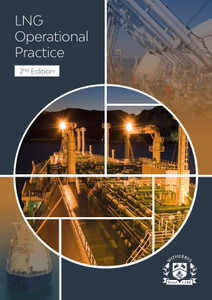
This book examines the transportation of liquefied gas by sea, covering the ships, products and rules and regulations. It also looks at cargo operations, transfer systems and shore storage facilities.
This book reviews the history of marine transportation of liquefied gas and provides an overview of all aspects of the industry. It looks at each stage of transportation, describing the characteristics of LPG, LNG and petrochemical gases, the types of ship used for their carriage, loading and discharging procedures, ship to ship transfer and onshore storage. It also identifies cargo hazards and provides case studies illustrating common causes of liquefied gas incidents.
The marine transportation of liquefied gases is a very small part of the shipping industry. With slightly more than 1,000 ships over one thousand cubic metre capacity, it does not stand comparison to the 3,000 chemical tankers, the 7,000 oil tankers and the 44,000 other types of ships of similar sizes. And yet, for many different reasons, it is a very important part of the shipping world. Compared to the rest of shipping, which is as old as the oldest civilisation, the marine transportation of liquefied gases is very new. It is just over 60 years since the first attempt was made to transport LPG in bulk and it is but 40 years since ‘Methane Pioneer’ carried the first cargo of LNG. LPG and LNG are among the least polluting of the energy sources known in the world today. The accidental release of a gas tanker’s cargo might result in a serious fire but little, if any, lasting environmental pollution. The safety record of the liquefied gas fleet is second to none and gas tankers are listed by all Port State Controls as the type of ship showing the least number of discrepancies. Paradoxically, liquefied gas ships have been described, in a certain type of alarmist literature, as being the potential cause of large catastrophic accidents. One famous book, published at the end of the 1970s, described in great detail how the whole of New York City would be reduced to ashes following the explosion of an LNG tanker, waiting to discharge at a terminal there. Good scaremongering fiction! But to anyone not directly involved in this branch of the shipping industry, the marine transportation of liquefied gases can seem mysterious and remote.
This book is a very modest attempt at giving interested parties a brief description of some aspects of the marine transportation of liquefied gases. What are the products covered by the term liquefied gases, what sort of ships are used for their carriage, how are these ships loaded and discharged, how are the products stored on shore before being loaded on the ships, these are questions which, hopefully, should appear slightly clearer to whoever is brave enough or interested enough to read this book.
Chapter 1 – Introduction
Chapter 2 – The Products
2.1 Liquefied Petroleum Gas (LPG) – Origins and Characteristics
2.2 Liquefied Natural Gas (LNG) – Origins and Characteristics
2.3 Liquefied Petrochemical Gases
Chapter 3 – History
3.1 Liquefied Petroleum Gas (LPG)
3.2 Liquefied Natural Gas (LNG)
Chapter 4 – The International Trade
4.1 Liquefied Petroleum and Petrochemical Gases
4.2 Liquefied Natural Gas (LNG)
Chapter 5 – Various Types of Liquefied Gas Tankers
5.1 General – The IMO Code Definitions
5.2 Fully Pressurised Ships
5.3 Semi-pressurised Ships
5.4 Fully Refrigerated Ships
5.5 Insulated Ships for LNG
Chapter 6 – Other Characteristics Specific to Liquefied Gas Tankers
6.1 General
6.2 Rules and Regulations
6.3 Cargo Equipment
6.4 Safety Equipment
Chapter 7 – Ports, Terminals and Jetties
7.1 Reducing the Level of Risk
7.2 Location, Design and Construction
7.3 Operational Procedures
Chapter 8 – Shore Storage Tanks
8.1 General
8.2 Storage under Pressure at Ambient Temperature
8.3 Storage in Semi-pressurised Spheres
8.4 Storage at Atmospheric Pressure in Refrigerated Condition
8.5 Evolution of the Size of Shore Tanks
8.6 Some Possible Incidents in Liquefied Gas Shore Storage Tanks
Chapter 9 – Operations
9.1 Ship Operations
9.2 Port Operations
Chapter 10 – Ship to Ship Transfer
10.1 LPG and Petrochemical Gases
10.2 LNG
Chapter 11 – Safety of Liquefied Gas Marine Transportation
11.1 Safety Record
11.2 Hazards and Risks
Chapter 12 – Some Stories
12.1 Accidents involving LNG and LPG Storage Tanks
12.2 Two Accidents involving LNG Tankers
12.3 Accidents involving LPG Tankers
12.4 Some other Incidents from my own Records
Alain Vaudolon started his seagoing career as an engineer cadet in 1959, finishing as chief engineer on a semi-pressurised LPG carrier at the end of the 1960s. He then held technical and operational posts in LPG and LNG carrier fleets in various parts of the world. This included two Malaysian LNG shipping projects, where he was closely involved in the design, construction supervision, acceptance of delivery and organisation of the operation of two series of five, French built, LNG tankers. In July 1995, Alain Vaudolon was appointed General Manager of the Society of International Gas Tanker and Terminal Operators (SIGTTO), a position he held until January 1999.
- Number of Pages:
- 178
- ISBN:
- 9781856091978
- Binding Format:
- Hardback
- Book Height:
- 300 mm
- Book Width:
- 210 mm
- Weight:
- 0.8 kg
- Author:
Alain Vaudolon
- Published Date:
- September 2000
- Preview:
- Yes





